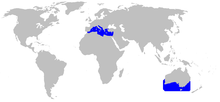Posidonia
| Posidonia | |
|---|---|
 | |
| Scientific classification | |
| Kingdom: | Plantae |
| (unranked): | Angiosperms |
| (unranked): | Monocots |
| Order: | Alismatales |
| Family: | Posidoniaceae Hutch.[1] |
| Genus: | Posidonia K.D.Koenig |
| Species | |
|
See text. | |
 | |
| Posidonia distribution range | |
Posidonia is a genus of flowering plants. It contains two to nine species of marine plants ("seagrass"), found in the seas of the Mediterranean and around the south coast of Australia.
The APG system (1998) and APG II system (2003) accept this genus as constituting the sole genus in the family Posidoniaceae, which it places in the order Alismatales, in the clade monocots. The AP-Website concludes that the three families Cymodoceaceae, Posidoniaceae and Ruppiaceae form a monophyletic group. Earlier systems classified this genus in the family Potamogetonaceae or in the family Posidoniaceae but belonging to order Zosterales.
Species
This is a list of species that are nominally contained by the genus:[2]
- Posidonia angustifolia Cambridge and Kuo[3]
- Posidonia australis Hook.f. South coast of Australia.
- Posidonia coriacea Cambridge and Kuo
- Posidonia denhartogii Kuo and Cambridge[4]
- Posidonia kirkmanii Kuo and Cambridge
- Posidonia oceanica (L.) Delile - This plant is endemic to the Mediterranean Sea, where it forms undersea meadows.
- Posidonia ostenfeldii den Hartog[5]
- Posidonia robertsoniae Kuo and Cambridge
- Posidonia sinuosa Cambridge and Kuo
The species described by Linnaeus, Posidonia oceanica, is found in the Mediterranean; the rest are located around the southern coast of Australia. Some species are endemic seagrasses of Western Australia, all the Australian species are found in that region's diverse habitats. This arrangement was divided into two complexes: the Posidonia australis and Posidonia ostenfeldii groups.[6] Some species descriptions may only be regional characteristics, and may need further revision.[2][7]
In 2006 a huge clonal colony of P. oceanica was discovered south of the island of Ibiza. At 8 km across and possibly up to 100,000 years of age, it may be one of the largest and oldest clonal colonies on Earth.[8]
References
- ↑ Angiosperm Phylogeny Group (2009). "An update of the Angiosperm Phylogeny Group classification for the orders and families of flowering plants: APG III" (PDF). Botanical Journal of the Linnean Society 161 (2): 105–121. doi:10.1111/j.1095-8339.2009.00996.x. Retrieved 2013-06-26.
- 1 2 Mike van Keulen. "The genus Posidonia König (nom. cons.) (Posidoniaceae).". Murdoch University.
- ↑ Cambridge, M.L. and Kuo, J. (1979) Two new species of seagrass from Australia, Posidonia sinuosa and Posidonia angustifolia (Posidoniaceae). Aquat. Bot. 6, 307-328 f. Keulen
- ↑ Kuo, J. and Cambridge, M.L. (1984) A taxonomic study of the Posidonia ostenfeldii complex (Posidoniaceae) with descriptions of four new Australian seagrasses. Aquat. Bot. 20, 267-95. f. Keulen
- ↑ den Hartog, C. (1970) Seagrasses of the World. Verh. Kon. Ned. Akad. Wetens. Afd. Naturk. Ser. 2 59:139 f. Keulen
- ↑ Kuo, J. and McComb, A.J. (1989) In: "Biology of Seagrasses. A treatise on the biology of seagrasses with special reference to the Australian region." (Eds. A.W.D. Larkum, A.J. McComb, S.A. Shepherd) (Aquatic Plant Studies 2) (Elsevier, Amsteredam). p. 6-73 f. Keulen
- ↑ Campey, M.L.; Waycott M.; Kendrick G.A. (January 2000). "Re-evaluating species boundaries among members of the Posidonia ostenfeldii species complex (Posidoniaceae) - morphological and genetic variation". Aquatic Botany 66 (1): 41–56(16) Research article. doi:10.1016/S0304-3770(99)00015-7.
- ↑ Ibiza Spotlight (28 May 2006). "Ibiza's Monster Marine Plant". Retrieved 2014-08-13.
External links
| External identifiers for Posidonia | |
|---|---|
| Encyclopedia of Life | 101673 |
| ITIS | 39059 |
| NCBI | 55487 |
| WoRMS | 144232 |
| Also found in: Wikispecies, NPGS/GRIN | |
![]() Media related to Posidonia at Wikimedia Commons
Media related to Posidonia at Wikimedia Commons
- "Posidonia K.D.Koenig nom. cons.". Australian Plant Name Index (APNI), IBIS database. Centre for Plant Biodiversity Research, Australian Government.
- Posidoniaceae in L. Watson and M. J. Dallwitz (1992 onwards) The families of flowering plants.
- Flora Europaea: Posidonia